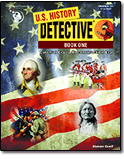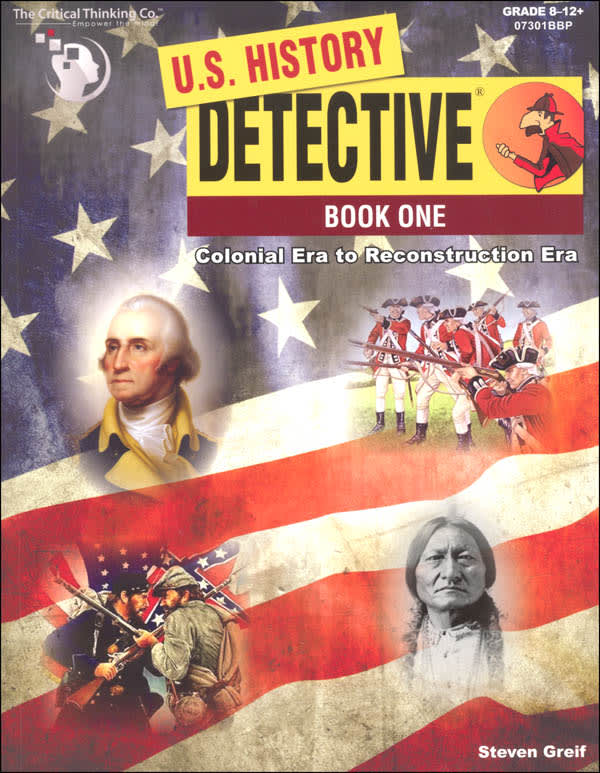U.S. History Detective, Book One is very similar in format to World History Detective, even though it is by a different author. It can be used as your core U.S. History course or alongside real books or other supplemental material for students in junior and senior high.
Book One covers from the colonial era up through reconstruction. Book Two will continue with the rest of U.S. History, but it is not yet available. To use U.S. History Detective as your core curriculum, you either need to supplement each volume and complete one book per year or else use both volumes in one year.
There are 65 lessons in Book One, and I expect that Book Two will have a similar number of lessons. So to finish both books in one year would require students to complete an average of 80 percent of a lesson each day. I think many eighth graders should be able to handle that as long as they have already learned to write short essay responses, and high school students should definitely be able to work at that pace. However, if students have weak writing skills, the essay answers will overwhelm them and you'll need to work at a slower pace, taking about two days per lesson. While the course is recommended for grades eight through twelve, I think it will work for seventh graders as well. For high schoolers, I think you need to use both Book One and Book Two for a full-year course.
Most lessons have two pages of text material followed by a series of nine questions. The majority of the questions are multiple-choice, but some questions require short written answers from a word or two up to a paragraph long. Lessons conclude with a “Written Response Question” that requires a half-page essay response. Students should be able to answer these questions without additional research. Lines for writing these essays are in the book, but there might not be sufficient space. You might have students write essay responses in a separate notebook.
There are occasional bonus activities that are more creative than the other lesson material; students are likely to find them interesting. A few graphic organizers are included for some lessons. “Fun Fact Finales” at the end of each lesson are boxes with snippets of interesting information that tie to topics within the lesson.
Frequent reviews cover a number of previous lessons, but these vary in format from work with graphic organizers to matching columns and completing charts. There is no final exam. An answer key is at the back of the book includes key points that should be included in essay responses. Parents might want to remove those pages and keep them separate.
The book is printed with both black-and-white and full-color illustrations. Images include both historic and modern photos, maps, graphs, political cartoons, and drawings. Political cartoons are frequently used as subjects for analysis and critical thinking.
The information generally reads like a textbook. However, every sentence has an identifying paragraph letter and sentence number. Many of the multiple-choice questions are followed by one or more lines for the student to identity which sentence or sentences best support their answers. They will use the paragraph letters and sentence numbers to answer those questions. (These are the type of questions that show up on standardized tests supporting the Common Core.)
The book is written for a secular audience. There is one lesson on “Great Awakenings: Religious Reforms” that includes discussion of the Great Awakenings as well as information about Mormonism, Shakers, and Utopian communities. Aside from a mention of Mormonism elsewhere, I couldn't find any other coverage of religion's impact on U.S. History. (There is no index in the book, so it is possible I missed another mention of religion elsewhere.) While I think the lack of information on the impact of religious beliefs is a significant omission, some parents might appreciate it.
The format of the questions requiring students to identify sentences that support their multiple-choice answers promotes reading comprehension, and it might also help students think more deeply about the information. Essay questions in every lesson are even more effective in that regard. These features make U.S. History Detective better than some other history courses in the critical thinking department.
No lesson planning or teaching is required with this course. Students can work independently although parents might need to get involved if students need to develop skills in writing their essay responses.
Ease of use, suitability for independent study, and thought-provoking questions all make U.S. History Detective a practical option for homeschoolers studying U.S. History.










